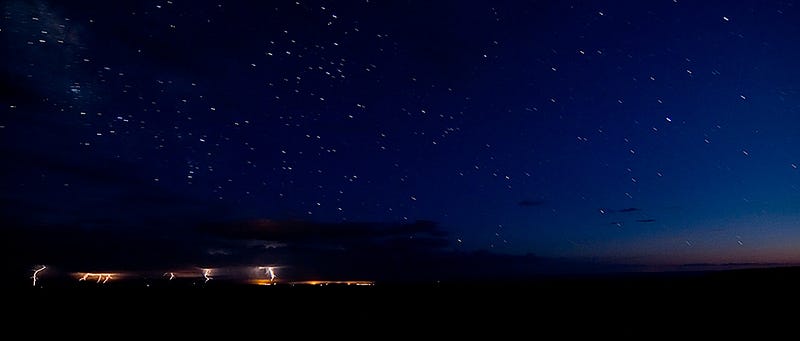Weekend Diversion: Lightning Nightscapes
Two amazing sights of the night sky captured together!
“It is like writing history with lightning and my only regret is that it is all so terribly true.” -Woodrow Wilson
If you’ve ever had the chance to be enthralled by dark, clear skies overhead, you’re well aware of some of the wondrous sights the Universe has to offer. Chances are you’ve also had occasion to check out the horizon during those fantastic opportunities, and it’s not an incredibly uncommon sight to have lightning strike, literally, during those experiences. I was fortunate enough to have that experience at a star party last summer, and to those of you who weren’t there to share it with me, I’d like to bring you a taste of that feeling.
Have a listen to virtuoso Richard Thompson’s amazing guitar work on 1952 Vincent Black Lightning,
while I share with you my ten favorite visuals that capture both the stellar nightscapes of the Universe beyond our world along with the fantastic electrical discharges released in our own atmosphere!

10.) Bob King, 2012. One of the challenges of catching lightning on film is that you generally need to do a long-exposure photo to have a chance at catching a discharge. But simultaneously, if you expose your photo for too long, you’re going to start to get star trails as the Earth rotates. This is a great (and fortunate) photo that catches the lightning with the stars still shining as bright, point-like dots in the sky.

9.) Greg Goodman, 2012. Quite often, a lightning storm will be accompanied by overcast skies, making it practically impossible to capture the lightning and the starry skies simultaneously. But in this photo, Greg took advantage of a short-lived break in the clouds to catch both sights at once. The astute among you will be able to spot six of the seven Big Dipper stars in the frame as well.

8.) Chris P. Zero, 2009. On the rim of the Grand Canyon, clear, dark skies are a frequent occurrence. (It’s where I, myself, first saw the Milky Way with my own eyes over a decade ago.) Yet — particularly in the summer — lightning storms sometimes happen as well, in this case, over the opposite rim. While the star-trails are clearly visible, so are multiple lightning strikes, a benefit of the long-exposure technique!

7.) Matt Prater (not the kicker), 2010. I love images of the night sky that really capture just how differently-colored stars are from one another, from the hot, blue stars to the cool, orange-and-red ones. While the clouds make it difficult, stars can often poke through, contrasting tremendously with the lightning illuminating the lower parts of the image.

6.) Francisco Negroni, 2011. This is a very rare shot, one that requires an ash plume from an active, erupting volcano! But in 2010, the Icelandic volcano Eyjafjallajökull erupted, and then in 2011 (shown here) Puyehue Volcano on the Chilean/Argentinian border did, both creating the spectacular phenomenon of volcanic lightning. Although clouds (and ash) block out most of the sky in this incredibly long-exposure image, the stars are still clearly visible in trails on the left, creating a spectacular composite!

5.) James Broscombe, 2010. On a typical night to a skywatcher, all clouds that block the light from the stars are pretty much the same: nuisances that do nothing but get in the way. Yet this serendipitous background flash of lightning threw the entire nightscape into tremendous relief, showing the incredible depth and structure of the clouds while still displaying a spectacular clear sky atop.

4.) WordPress user fayroy, 2011. This incredible shot of very dark Utah skies catpures a plethora of stars, the plane of the Milky Way and a couple of shooting stars at right, while a lightning strike at left in the distance lights up the distant clouds. While the “flash” of lightning only happens for a fraction of a second, in contrast to the stars that take around 15-45 seconds of exposure just to become visible, this photo (perhaps unintentionally) shows both the lightning and the night sky with the same brightness.

3.) Martin Kucera, 2005. Combining the rising Moon, a number of lightning strikes with a prominent cloud presence and hundreds of stars clearly visible. What I love about this is the reflection of the lightning in the Florida Keys water. Martin is also responsible for the image atop this page, and more of his images from the 2005 lightning storm season are up here.
2.) Brad Scott, 2013. This wonderful video from just a few months ago shows a spectacular Hawaiian night sky over many hours, with a number of lightning strikes visible in the distance. This is one of my favorite uses for a time-lapse: showcasing phenomena that are often difficult to capture in single photographs. You can check out more from Brad Scott here.
And finally…

Image credit: Phill Monson, of http://intothenightphoto.blogspot.com/2013/09/hoodoos-stars-and-lightning-by-phillip.html.
1.) Phillip Monson, 2013. What a composition! Taken in the pre-dawn skies after the Moon had set, this shot not only combines a furious lightning storm with a spectacular starry sky, but adds in the inimitable rock formations of southwest Utah. Naturally, these formations would be virtually invisible, and appear only as shadows, but by illuminating the rocks with spotlights, he was able to showcase the terrestrial rocks, the atmospheric lightning and the heavenly starscape all together.
And I hope these have delighted you as much as they have me! Have a great rest-of-your-weekend, and I’ll see you back here tomorrow for more natural wonders of the Universe!





